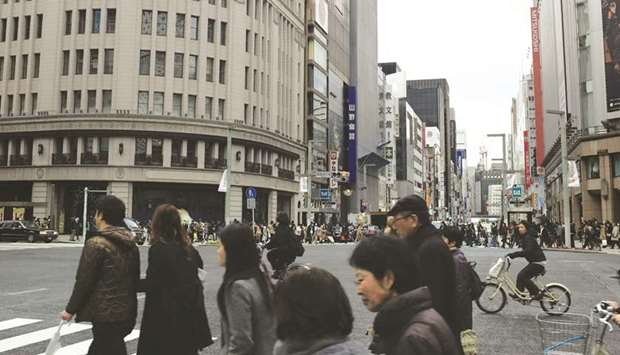The Japanese economy contracted the most in over four years in the third quarter as companies slashed spending, threatening to chill the investment outlook in 2019 as the export-reliant nation grapples with slowing global growth and trade frictions.
The slump in the world’s third-biggest economy adds to signs elsewhere in Asia and Europe of weakening momentum, with recent data in China and Australia showing a slowdown in growth and stoking concerns about the wider impact of the Sino-US trade war.
Japan’s gross domestic product shrank at an annualised rate of 2.5% in the July-September quarter — the worst downturn since the second quarter of 2014 — from 2.8% growth in the second quarter, revised data from the Cabinet Office showed.
The slide, in part driven by a series of natural disasters that forced factories to cut production, was deeper than an initial estimate of a 1.2% contraction and against economists’ median forecast for a 1.9% decline.
The capital expenditure component of GDP fell a sharp 2.8% from the second quarter, worse than the expected 1.6% decline and the preliminary reading of a 0.2% drop.
That was the biggest decrease since the third quarter of 2009, as wholesalers, retailers, and information and communications machinery cut spending, the Cabinet Office data showed. “Capex is decelerating in areas such as all-purpose machinery, production equipment and automobiles,” said Takeshi Minami, chief economist at Norinchukin Research Institute.
“Depending on extent of global slowdown and trade frictions, companies may put off their bullish spending plans or even make adjustments from the latter half of this fiscal year onwards.”
That risk — of businesses cutting back on spending — is a worry for policymakers who are counting on capital expenditure to boost growth and inflation.
Capex has been a bright spot in the economy since late 2016, underpinned by investment in automation and labour-saving technology to cope with labour shortages.
The capex slump is particularly worrying as it comes at a time of cooling global growth, a rising tide of protectionism and slowing company profits, all of which are putting a damper on business confidence.
Japanese manufacturers’ mood soured for a second straight month in December and is seen slipping further, a Reuters monthly poll showed on Thursday, pointing to declines in the central bank’s key tankan survey due out December 14.
While analysts expect the economy to stage a rebound in the current quarter as factories lift production following the natural disasters, there are worries the Sino-US trade war could crimp global growth and hurt export-led Japan.
In October, Japanese robot maker Fanuc Corp — which is highly exposed to the China market — slashed its outlook for the full year, citing slower technology spending and trade friction.
Earnings growth at other Japanese manufacturers is also being crimped by the US-China trade dispute, with Yaskawa Electric Corp, and Canon Inc among companies that downgraded their profit forecasts, reflecting cooling demand.
The revised GDP figure translates into quarter-on-quarter contraction of 0.6% in real, price-adjusted terms, against a preliminary reading of a 0.3% slide and economists’ median estimate of a 0.5% decline.
Private consumption, which accounts for roughly 60% of GDP, fell 0.2% in July-September from the previous three months, versus 0.1% drop seen in the initial estimate.
Domestic demand shaved 0.5 percentage points off the revised GDP figure, while net exports — or exports minus imports — contributed minus 0.1 percentage point.
Atsushi Takeda, chief economist at Itochu Economic Research Institute, said global headwinds suggest business spending is on the verge of “levelling off.”
“There may be a rebound in capex, but it cannot be a driver of the economy in the coming year, given growing uncertainty in the face of trade frictions, global economic slowdown and a planned sales tax hike at home.”

Pedestrians walk along a street in the Ginza shopping district in Tokyo. The Japanese economy contracted the most in over four years in the third quarter as companies slashed spending, threatening to chill the investment outlook in 2019 as the export-reliant nation grapples with slowing global growth and trade frictions.


